Metal Halide Perovskite Nanowires: Controllable Synthesis, Mechanism, and Application in Optoelectronic Devices
Abstract
1. Introduction
2. Synthesis of Perovskite Nanowires
2.1. Hot Injection
2.2. Vapor Growth
2.3. Selfassembly
2.3.1. Ligand-Assisted
2.3.2. Light-Induced
2.3.3. Polar Solvent Induction
2.4. Solvothermal
2.5. Anion Exchange
3. Application of Perovskite Nanowires
3.1. Lasers
3.2. Photodetectors
3.3. Solar Cells
4. Summary and Perspective
Author Contributions
Funding
Data Availability Statement
Conflicts of Interest
References
- Kim, Y.H.; Cho, H.; Heo, J.H.; Kim, T.S.; Myoung, N.; Lee, C.L.; Im, S.H.; Lee, T.W. Multicolored organic/inorganic hybrid perovskite light-emitting diodes. Adv. Mater. 2015, 27, 1248–1254. [Google Scholar] [CrossRef] [PubMed]
- Zou, Y.; Yuan, Z.; Bai, S.; Gao, F.; Sun, B. Recent progress toward perovskite light-emitting diodes with enhanced spectral and operational stability. Mater. Today Nano 2019, 5, 100028. [Google Scholar] [CrossRef]
- Tan, Z.-K.; Moghaddam, R.S.; Lai, M.L.; Docampo, P.; Higler, R.; Deschler, F.; Price, M.; Sadhanala, A.; Pazos, L.M.; Credgington, D. Bright light-emitting diodes based on organometal halide perovskite. Nat. Nanotechnol. 2014, 9, 687–692. [Google Scholar] [CrossRef] [PubMed]
- Song, J.; Li, J.; Li, X.; Xu, L.; Dong, Y.; Zeng, H. Quantum dot light-emitting diodes based on inorganic perovskite cesium lead halides (CsPbX3). Adv. Mater. 2015, 27, 7162–7167. [Google Scholar] [CrossRef]
- Li, J.; Xu, L.; Wang, T.; Song, J.; Chen, J.; Xue, J.; Dong, Y.; Cai, B.; Shan, Q.; Zeng, H. 50-Fold EQE improvement up to 6.27% of solution-processed all-inorganic perovskite CsPbBr3 QLEDs via surface ligand density control. Adv. Mater. 2017, 29, 1603885. [Google Scholar] [CrossRef]
- Wei, Q.; Li, X.; Liang, C.; Zhang, Z.; Guo, J.; Hong, G.; Xing, G.; Huang, W. Recent progress in metal halide perovskite micro-and nanolasers. Adv. Opt. Mater. 2019, 7, 1900080. [Google Scholar] [CrossRef]
- Schlaus, A.P.; Spencer, M.S.; Miyata, K.; Liu, F.; Wang, X.; Datta, I.; Lipson, M.; Pan, A.; Zhu, X.-Y. How lasing happens in CsPbBr3 perovskite nanowires. Nat. Commun. 2019, 10, 265. [Google Scholar] [CrossRef]
- Eaton, S.W.; Lai, M.; Gibson, N.A.; Wong, A.B.; Dou, L.; Ma, J.; Wang, L.-W.; Leone, S.R.; Yang, P. Lasing in robust cesium lead halide perovskite nanowires. Proc. Natl. Acad. Sci. USA 2016, 113, 1993–1998. [Google Scholar] [CrossRef]
- Wang, H.P.; Li, S.; Liu, X.; Shi, Z.; Fang, X.; He, J.H. Low-dimensional metal halide perovskite photodetectors. Adv. Mater. 2021, 33, 2003309. [Google Scholar] [CrossRef]
- Miao, J.; Zhang, F. Recent progress on highly sensitive perovskite photodetectors. J. Mater. Chem. C 2019, 7, 1741–1791. [Google Scholar] [CrossRef]
- Wang, H.; Kim, D.H. Perovskite-based photodetectors: Materials and devices. Chem. Soc. Rev. 2017, 46, 5204–5236. [Google Scholar] [CrossRef]
- Green, M.A.; Ho-Baillie, A.; Snaith, H.J. The emergence of perovskite solar cells. Nat. Photonics 2014, 8, 506–514. [Google Scholar] [CrossRef]
- Correa-Baena, J.-P.; Saliba, M.; Buonassisi, T.; Graetzel, M.; Abate, A.; Tress, W.; Hagfeldt, A. Promises and challenges of perovskite solar cells. Science 2017, 358, 739–744. [Google Scholar] [CrossRef]
- Li, X.; Wu, Y.; Zhang, S.; Cai, B.; Gu, Y.; Song, J.; Zeng, H. CsPbX3 quantum dots for lighting and displays: Room-temperature synthesis, photoluminescence superiorities, underlying origins and white light-emitting diodes. Adv. Funct. Mater. 2016, 26, 2435–2445. [Google Scholar] [CrossRef]
- Wang, Y.; Li, X.; Song, J.; Xiao, L.; Zeng, H.; Sun, H. All-inorganic colloidal perovskite quantum dots: A new class of lasing materials with favorable characteristics. Adv. Mater. 2015, 27, 7101–7108. [Google Scholar] [CrossRef]
- Zhang, D.; Eaton, S.W.; Yu, Y.; Dou, L.; Yang, P. Solution-phase synthesis of cesium lead halide perovskite nanowires. J. Am. Chem. Soc. 2015, 137, 9230–9233. [Google Scholar] [CrossRef]
- Fu, Y.; Zhu, H.; Stoumpos, C.C.; Ding, Q.; Wang, J.; Kanatzidis, M.G.; Zhu, X.; Jin, S. Broad wavelength tunable robust lasing from single-crystal nanowires of cesium lead halide perovskites (CsPbX3, X= Cl, Br, I). ACS Nano 2016, 10, 7963–7972. [Google Scholar] [CrossRef]
- Kumar, G.S.; Sumukam, R.R.; Rajaboina, R.K.; Savu, R.N.; Srinivas, M.; Banavoth, M. Perovskite nanowires for next-generation optoelectronic devices: Lab to Fab. ACS Appl. Energy Mater. 2022, 5, 1342–1377. [Google Scholar] [CrossRef]
- Zhang, X.; Chen, S.; Wang, X.; Pan, A. Controlled synthesis and photonics applications of metal halide perovskite nanowires. Small Methods 2019, 3, 1800294. [Google Scholar] [CrossRef]
- Hong, K.; Le, Q.V.; Kim, S.Y.; Jang, H.W. Low-dimensional halide perovskites: Review and issues. J. Mater. Chem. C 2018, 6, 2189–2209. [Google Scholar] [CrossRef]
- Qiu, T.; Hu, Y.; Xu, F.; Yan, Z.; Bai, F.; Jia, G.; Zhang, S. Recent advances in one-dimensional halide perovskites for optoelectronic applications. Nanoscale 2018, 10, 20963–20989. [Google Scholar] [CrossRef] [PubMed]
- Wang, M.; Cao, F.; Li, L. Metal halide perovskite nano/microwires. Small Struct. 2022, 3, 2100165. [Google Scholar] [CrossRef]
- Liang, D.; Peng, Y.; Fu, Y.; Shearer, M.J.; Zhang, J.; Zhai, J.; Zhang, Y.; Hamers, R.J.; Andrew, T.L.; Jin, S. Color-pure violet-light-emitting diodes based on layered lead halide perovskite nanoplates. ACS Nano 2016, 10, 6897–6904. [Google Scholar] [CrossRef] [PubMed]
- Bekenstein, Y.; Koscher, B.A.; Eaton, S.W.; Yang, P.; Alivisatos, A.P. Highly luminescent colloidal nanoplates of perovskite cesium lead halide and their oriented assemblies. J. Am. Chem. Soc. 2015, 137, 16008–16011. [Google Scholar] [CrossRef] [PubMed]
- Chen, B.; Rudd, P.N.; Yang, S.; Yuan, Y.; Huang, J. Imperfections and their passivation in halide perovskite solar cells. Chem. Soc. Rev. 2019, 48, 3842–3867. [Google Scholar] [CrossRef]
- Liu, P.; Han, N.; Wang, W.; Ran, R.; Zhou, W.; Shao, Z. High-quality ruddlesden–popper perovskite film formation for high-performance perovskite solar cells. Adv. Mater. 2021, 33, 2002582. [Google Scholar] [CrossRef]
- Zhang, H.; Nazeeruddin, M.K.; Choy, W.C. Perovskite photovoltaics: The significant role of ligands in film formation, passivation, and stability. Adv. Mater. 2019, 31, 1805702. [Google Scholar] [CrossRef]
- Zhang, D.; Yang, Y.; Bekenstein, Y.; Yu, Y.; Gibson, N.A.; Wong, A.B.; Eaton, S.W.; Kornienko, N.; Kong, Q.; Lai, M. Synthesis of composition tunable and highly luminescent cesium lead halide nanowires through anion-exchange reactions. J. Am. Chem. Soc. 2016, 138, 7236–7239. [Google Scholar] [CrossRef]
- Dey, A.; Ye, J.; De, A.; Debroye, E.; Ha, S.K.; Bladt, E.; Kshirsagar, A.S.; Wang, Z.; Hoye, R.L.Z.; Polavarapu, L. State of the art and prospects for halide perovskite nanocrystals. ACS Nano 2021, 15, 10775–10981. [Google Scholar] [CrossRef]
- Quan, L.N.; Kang, J.; Ning, C.-Z.; Yang, P. Nanowires for photonics. Chem. Rev. 2019, 119, 9153–9169. [Google Scholar] [CrossRef]
- Zhang, N.; Xia, K.; He, Q.; Pan, J. Recent progress in the stability of red-emissive perovskite nanocrystals for light-emitting diodes. ACS Mater. Lett. 2022, 4, 1233–1254. [Google Scholar] [CrossRef]
- Pan, J.; Quan, L.N.; Zhao, Y.; Peng, W.; Murali, B.; Sarmah, S.P.; Yuan, M.; Sinatra, L.; Sargent, E.H.; Bakr, O.M. Highly efficient perovskite-quantum-dot light-emitting diodes by surface engineering. Adv. Mater. 2016, 28, 8718–8725. [Google Scholar] [CrossRef]
- Gong, M.; Sakidja, R.; Goul, R.; Ewing, D.; Casper, M.; Stramel, A.; Elliot, A.; Wu, J.Z. High-performance all-inorganic CsPbCl3 perovskite nanocrystal photodetectors with superior stability. ACS Nano 2019, 13, 1772–1783. [Google Scholar] [CrossRef]
- Boles, M.A.; Engel, M.; Talapin, D.V. Self-assembly of colloidal nanocrystals: From intricate structures to functional materials. Chem. Rev. 2016, 116, 11220–11289. [Google Scholar] [CrossRef]
- Jana, A.; Meena, A.; Patil, S.A.; Jo, Y.; Cho, S.; Park, Y.; Sree, V.G.; Kim, H.; Im, H.; Taylor, R.A. Self-assembly of perovskite nanocrystals. Prog. Mater Sci. 2022, 129, 100975. [Google Scholar] [CrossRef]
- Zhang, D.; Zhang, Q.; Zhu, Y.; Poddar, S.; Zhang, Y.; Gu, L.; Zeng, H.; Fan, Z. Metal halide perovskite nanowires: Synthesis, integration, properties, and applications in optoelectronics. Adv. Energy Mater. 2022, 2201735. [Google Scholar] [CrossRef]
- Protesescu, L.; Yakunin, S.; Bodnarchuk, M.I.; Krieg, F.; Caputo, R.; Hendon, C.H.; Yang, R.X.; Walsh, A.; Kovalenko, M.V. Nanocrystals of cesium lead halide perovskites (CsPbX3, X= Cl, Br, and I): Novel optoelectronic materials showing bright emission with wide color gamut. Nano Lett. 2015, 15, 3692–3696. [Google Scholar] [CrossRef] [PubMed]
- Chen, Z.; Dong, L.; Tang, H.; Yu, Y.; Ye, L.; Zang, J. Direct synthesis of cubic phase CsPbI3 nanowires. CrystEngComm 2019, 21, 1389–1396. [Google Scholar] [CrossRef]
- Imran, M.; Di Stasio, F.; Dang, Z.; Canale, C.; Khan, A.H.; Shamsi, J.; Brescia, R.; Prato, M.; Manna, L. Colloidal synthesis of strongly fluorescent CsPbBr3 nanowires with width tunable down to the quantum confinement regime. Chem. Mater. 2016, 28, 6450–6454. [Google Scholar] [CrossRef] [PubMed]
- Zhang, D.; Yu, Y.; Bekenstein, Y.; Wong, A.B.; Alivisatos, A.P.; Yang, P. Ultrathin colloidal cesium lead halide perovskite nanowires. J. Am. Chem. Soc. 2016, 138, 13155–13158. [Google Scholar] [CrossRef] [PubMed]
- Xing, J.; Liu, X.F.; Zhang, Q.; Ha, S.T.; Yuan, Y.W.; Shen, C.; Sum, T.C.; Xiong, Q. Vapor phase synthesis of organometal halide perovskite nanowires for tunable room-temperature nanolasers. Nano Lett. 2015, 15, 4571–4577. [Google Scholar] [CrossRef]
- Waleed, A.; Tavakoli, M.M.; Gu, L.; Hussain, S.; Zhang, D.; Poddar, S.; Wang, Z.; Zhang, R.; Fan, Z. All inorganic cesium lead iodide perovskite nanowires with stabilized cubic phase at room temperature and nanowire array-based photodetectors. Nano Lett. 2017, 17, 4951–4957. [Google Scholar] [CrossRef]
- Chen, J.; Fu, Y.; Samad, L.; Dang, L.; Zhao, Y.; Shen, S.; Guo, L.; Jin, S. Vapor-phase epitaxial growth of aligned nanowire networks of cesium lead halide perovskites (CsPbX3, X= Cl, Br, I). Nano Lett. 2017, 17, 460–466. [Google Scholar] [CrossRef]
- Oksenberg, E.; Sanders, E.; Popovitz-Biro, R.; Houben, L.; Joselevich, E. Surface-guided CsPbBr3 perovskite nanowires on flat and faceted sapphire with size-dependent photoluminescence and fast photoconductive response. Nano Lett. 2018, 18, 424–433. [Google Scholar] [CrossRef]
- Meyers, J.K.; Kim, S.; Hill, D.J.; Cating, E.E.M.; Williams, L.J.; Kumbhar, A.S.; McBride, J.R.; Papanikolas, J.M.; Cahoon, J.F. Self-catalyzed vapor-liquid-solid growth of lead halide nanowires and conversion to hybrid perovskites. Nano Lett. 2017, 17, 7561–7568. [Google Scholar] [CrossRef]
- Shim, H.; Shin, N. VLS homoepitaxy of lead Iodide nanowires for hybrid perovskite conversion. J. Phys. Chem. Lett. 2019, 10, 6741–6749. [Google Scholar] [CrossRef]
- Meng, Y.; Lan, C.; Li, F.; Yip, S.; Wei, R.; Kang, X.; Bu, X.; Dong, R.; Zhang, H.; Ho, J.C. Direct vapor-liquid-solid synthesis of all-inorganic perovskite nanowires for high-performance electronics and optoelectronics. ACS Nano 2019, 13, 6060–6070. [Google Scholar] [CrossRef]
- Zhang, F.; Chen, C.; Kershaw, S.V.; Xiao, C.; Han, J.; Zou, B.; Wu, X.; Chang, S.; Rogach, A.L.; Zhong, H. Ligand-controlled formation and photoluminescence properties of CH3NH3PbBr3 nanocubes and nanowires. ChemNanoMat 2017, 3, 303–310. [Google Scholar] [CrossRef]
- Pan, J.; Li, X.; Gong, X.; Yin, J.; Zhou, D.; Sinatra, L.; Mohammed, O.F.; Ye, C.; Sargent, E.H.; Bakr, O.M. Halogen vacancies enable ligand-assisted self-assembly of perovskite quantum dots into nanowires. Angew. Chem. Int. Ed. 2019, 58, 16077–16081. [Google Scholar] [CrossRef]
- Liu, J.; Song, K.; Shin, Y.; Liu, X.; Chen, J.; Yao, K.X.; Pan, J.; Mohammed, O.F.; Han, Y.; Bakr, O.M. Light-induced self-assembly of cubic CsPbBr3 perovskite nanocrystals into nanowires. Chem. Mater. 2019, 31, 6642–6649. [Google Scholar] [CrossRef]
- Sun, J.K.; Huang, S.; Liu, X.Z.; Xu, Q.; Zhang, Q.H.; Jiang, W.J.; Xue, D.J.; Xu, J.C.; Hu, J.S.; Wan, L.J. Polar solvent induced lattice distortion of cubic CsPbI3 nanocubes and hierarchical self-assembly into orthorhombic single-crystalline nanowires. J. Am. Chem. Soc. 2018, 140, 11705–11715. [Google Scholar] [CrossRef] [PubMed]
- He, L.; Pan, S.; Lin, Z.; Peng, J. Rapid route to polar solvent-directed growth of perovskite nanowires. ACS Appl. Nano Mater. 2019, 2, 7910–7915. [Google Scholar] [CrossRef]
- Chen, M.; Zou, Y.; Wu, L.; Pan, Q.; Yang, D.; Hu, H.; Tan, Y.; Xu, Y.; Sun, B.; Zhang, Q. Solvothermal synthesis of high-quality all-inorganic cesium lead halide perovskite nanocrystals: From nanocube to ultrathin nanowire. Adv. Funct. Mater. 2017, 27, 1701121. [Google Scholar] [CrossRef]
- Tong, Y.; Bohn, B.J.; Bladt, E.; Wang, K.; Müller-Buschbaum, P.; Bals, S.; Urban, A.S.; Polavarapu, L.; Feldmann, J. From precursor powders to CsPbX3 perovskite nanowires: One-pot synthesis, growth mechanism, and oriented self-assembly. Angew. Chem. Int. Ed. 2017, 56, 13887–13892. [Google Scholar] [CrossRef] [PubMed]
- Murray, C.; Norris, D.J.; Bawendi, M.G. Synthesis and characterization of nearly monodisperse CdE (E= sulfur, selenium, tellurium) semiconductor nanocrystallites. J. Am. Chem. Soc. 1993, 115, 8706–8715. [Google Scholar] [CrossRef]
- de Mello Donegá, C.; Liljeroth, P.; Vanmaekelbergh, D. Physicochemical evaluation of the hot-injection method, a synthesis route for monodisperse nanocrystals. Small 2005, 1, 1152–1162. [Google Scholar] [CrossRef]
- Guesnay, Q.; Sahli, F.; Ballif, C.; Jeangros, Q. Vapor deposition of metal halide perovskite thin films: Process control strategies to shape layer properties. APL Mater. 2021, 9, 100703. [Google Scholar] [CrossRef]
- Tan, C.; Chen, J.; Wu, X.-J.; Zhang, H. Epitaxial growth of hybrid nanostructures. Nat. Rev. Mater. 2018, 3, 1–13. [Google Scholar] [CrossRef]
- Güniat, L.; Caroff, P.; Fontcuberta i Morral, A. Vapor phase growth of semiconductor nanowires: Key developments and open questions. Chem. Rev. 2019, 119, 8958–8971. [Google Scholar] [CrossRef]
- Ha, S.T.; Liu, X.; Zhang, Q.; Giovanni, D.; Sum, T.C.; Xiong, Q. Synthesis of organic–inorganic lead halide perovskite nanoplatelets: Towards high-performance perovskite solar cells and optoelectronic devices. Adv. Opt. Mater. 2014, 2, 838–844. [Google Scholar] [CrossRef]
- Zhou, H.; Yuan, S.; Wang, X.; Xu, T.; Wang, X.; Li, H.; Zheng, W.; Fan, P.; Li, Y.; Pan, A. Vapor growth and tunable lasing of band gap engineered cesium lead halide perovskite micro/nanorods with triangular cross section. ACS Nano 2017, 11, 1189–1195. [Google Scholar] [CrossRef]
- Wang, Y.; Sun, X.; Shivanna, R.; Yang, Y.; Chen, Z.; Guo, Y.; Wang, G.-C.; Wertz, E.; Deschler, F.; Cai, Z. Photon transport in one-dimensional incommensurately epitaxial CsPbX3 arrays. Nano Lett. 2016, 16, 7974–7981. [Google Scholar] [CrossRef]
- Zhang, Q.; Su, R.; Liu, X.; Xing, J.; Sum, T.C.; Xiong, Q. High-quality whispering-gallery-mode lasing from cesium lead halide perovskite nanoplatelets. Adv. Funct. Mater. 2016, 26, 6238–6245. [Google Scholar] [CrossRef]
- Samuelson, L. Self-forming nanoscale devices. Mater. Today 2003, 6, 22–31. [Google Scholar] [CrossRef]
- Thelander, C.; Agarwal, P.; Brongersma, S.; Eymery, J.; Feiner, L.-F.; Forchel, A.; Scheffler, M.; Riess, W.; Ohlsson, B.; Samuelson, L. Nanowire-based one-dimensional electronics. Mater. Today 2006, 9, 28–35. [Google Scholar] [CrossRef]
- Li, Y.; Qian, F.; Xiang, J.; Lieber, C.M. Nanowire electronic and optoelectronic devices. Mater. Today 2006, 9, 18–27. [Google Scholar] [CrossRef]
- Pauzauskie, P.J.; Yang, P. Nanowire photonics. Mater. Today 2006, 9, 36–45. [Google Scholar] [CrossRef]
- Yang, Z.-X.; Liu, L.; Yip, S.; Li, D.; Shen, L.; Zhou, Z.; Han, N.; Wu, X.; Song, A.; Ho, J.C. Complementary metal oxide semiconductor-compatible, high-mobility, < 111 >-oriented GaSb nanowires enabled by vapor-solid-solid chemical vapor deposition. ACS Nano 2017, 11, 4237–4246. [Google Scholar]
- Sun, J.; Yin, Y.; Han, M.; Yang, Z.-x.; Lan, C.; Liu, L.; Wang, Y.; Han, N.; Shen, L.; Ho, J.C. Nonpolar-oriented wurtzite InP nanowires with electron mobility approaching the theoretical limit. ACS Nano 2018, 12, 10410–10418. [Google Scholar] [CrossRef]
- Klamchuen, A.; Suzuki, M.; Nagashima, K.; Yoshida, H.; Kanai, M.; Zhuge, F.; Kai, S.; Takeda, S.; Kawai, T.; Yanagida, T. Rational concept for designing vapor-liquid-solid growth of single crystalline metal oxide nanowires. Nano Lett. 2015, 15, 6406–6412. [Google Scholar] [CrossRef]
- Wei, Y.; Cheng, Z.; Lin, J. An overview on enhancing the stability of lead halide perovskite quantum dots and their applications in phosphor-converted LEDs. Chem. Soc. Rev. 2019, 48, 310–350. [Google Scholar] [CrossRef] [PubMed]
- Kovalenko, M.V.; Protesescu, L.; Bodnarchuk, M.I. Properties and potential optoelectronic applications of lead halide perovskite nanocrystals. Science 2017, 358, 745–750. [Google Scholar] [CrossRef] [PubMed]
- Ma, J.P.; Yin, J.; Chen, Y.M.; Zhao, Q.; Zhou, Y.; Li, H.; Kuroiwa, Y.; Bakr, O.M.; Mohammed, O.F.; Sun, H.T. Defect-triggered phase transition in cesium lead halide perovskite nanocrystals. ACS Mater. Lett. 2019, 1, 185–191. [Google Scholar] [CrossRef]
- Pan, J.; Sarmah, S.P.; Murali, B.; Dursun, I.; Peng, W.; Parida, M.R.; Liu, J.; Sinatra, L.; Bakr, O.M.; Mohammed, O.F. Air-stable surface-passivated perovskite quantum dots for ultra-robust, single- and two-photon-induced amplified spontaneous emission. J. Phys. Chem. Lett. 2015, 6, 5027–5033. [Google Scholar] [CrossRef] [PubMed]
- Grzelczak, M.; Liz-Marzán, L.M.; Klajn, R. Stimuli-responsive self-assembly of nanoparticles. Chem. Soc. Rev. 2019, 48, 1342–1361. [Google Scholar] [CrossRef]
- Queisser, H.J.; Haller, E.E. Defects in semiconductors: Some fatal, some vital. Science 1998, 281, 945–950. [Google Scholar] [CrossRef]
- Zhang, F.; Zhong, H.; Chen, C.; Wu, X.-G.; Hu, X.; Huang, H.; Han, J.; Zou, B.; Dong, Y. Brightly luminescent and color-tunable colloidal CH3NH3PbX3 (X = Br, I, Cl) quantum dots: Potential alternatives for display technology. ACS Nano 2015, 9, 4533–4542. [Google Scholar] [CrossRef]
- Kirschner, M.S.; Diroll, B.T.; Guo, P.; Harvey, S.M.; Helweh, W.; Flanders, N.C.; Brumberg, A.; Watkins, N.E.; Chen, L.X.; Schaller, R.D. Photoinduced, reversible phase transitions in all-inorganic perovskite nanocrystals. Nat. Commun. 2019, 10, 504. [Google Scholar] [CrossRef]
- Sarmah, S.P.; Burlakov, V.M.; Yengel, E.; Murali, B.; Alarousu, E.; El-Zohry, A.M.; Yang, C.; Alias, M.S.; Bakr, O.M.; Mohammed, O.F. Double charged surface layers in lead halide perovskite crystals. Nano Lett. 2017, 17, 2021–2027. [Google Scholar] [CrossRef]
- Kim, G.Y.; Senocrate, A.; Yang, T.-Y.; Gregori, G.; Grätzel, M.; Maier, J. Large tunable photoeffect on ion conduction in halide perovskites and implications for photodecomposition. Nat. Mater. 2018, 17, 445–449. [Google Scholar] [CrossRef]
- Bakr, O.M.; Mohammed, O.F. Shedding light on film crystallization. Nat. Mater. 2017, 16, 601–602. [Google Scholar] [CrossRef]
- Klajn, R.; Bishop, K.J.M.; Grzybowski, B.A. Light-controlled self-assembly of reversible and irreversible nanoparticle suprastructures. Proc. Natl. Acad. Sci. USA 2007, 104, 10305–10309. [Google Scholar] [CrossRef]
- Sun, S.; Yuan, D.; Xu, Y.; Wang, A.; Deng, Z. Ligand-mediated synthesis of shape-controlled cesium lead halide perovskite nanocrystals via reprecipitation process at room temperature. ACS Nano 2016, 10, 3648–3657. [Google Scholar] [CrossRef]
- Sun, Y.; Zhang, H.; Zhu, K.; Ye, W.; She, L.; Gao, X.; Ji, W.; Zeng, Q. Research on the influence of polar solvents on CsPbBr3 perovskite QDs. RSC Adv. 2021, 11, 27333–27337. [Google Scholar] [CrossRef]
- Parveen, S.; Paul, K.K.; Giri, P.K. Precise tuning of the thickness and optical properties of highly stable 2D organometal halide perovskite nanosheets through a solvothermal process and their applications as a white LED and a fast photodetector. ACS Appl. Mater. Interfaces 2020, 12, 6283–6297. [Google Scholar] [CrossRef]
- Nedelcu, G.; Protesescu, L.; Yakunin, S.; Bodnarchuk, M.I.; Grotevent, M.J.; Kovalenko, M.V. Fast anion-exchange in highly luminescent nanocrystals of cesium lead halide perovskites (CsPbX3, X = Cl, Br, I). Nano Lett. 2015, 15, 5635–5640. [Google Scholar] [CrossRef]
- Dou, L.; Lai, M.; Kley, C.S.; Yang, Y.; Bischak, C.G.; Zhang, D.; Eaton, S.W.; Ginsberg, N.S.; Yang, P. Spatially resolved multicolor CsPbX₃ nanowire heterojunctions via anion exchange. Proc. Natl. Acad. Sci. USA 2017, 114, 7216–7221. [Google Scholar] [CrossRef]
- Lai, M.; Obliger, A.; Lu, D.; Kley, C.S.; Bischak, C.G.; Kong, Q.; Dou, L.; Ginsberg, N.S.; Limmer, D.T.; Yang, P. Intrinsic anion diffusivity in lead halide perovskites is facilitated by a soft lattice. Proc. Natl. Acad. Sci. USA 2018, 115, 11929–11934. [Google Scholar] [CrossRef]
- Pan, D.; Fu, Y.; Chen, J.; Czech, K.J.; Wright, J.C.; Jin, S. Visualization and studies of ion-diffusion kinetics in cesium lead bromide perovskite nanowires. Nano Lett. 2018, 18, 1807–1813. [Google Scholar] [CrossRef]
- Dou, L.; Yang, Y.M.; You, J.; Hong, Z.; Chang, W.-H.; Li, G.; Yang, Y. Solution-processed hybrid perovskite photodetectors with high detectivity. Nat. Commun. 2014, 5, 5404. [Google Scholar] [CrossRef]
- Zhu, H.; Fu, Y.; Meng, F.; Wu, X.; Gong, Z.; Ding, Q.; Gustafsson, M.V.; Trinh, M.T.; Jin, S.; Zhu, X. Lead halide perovskite nanowire lasers with low lasing thresholds and high quality factors. Nat. Mater. 2015, 14, 636–642. [Google Scholar] [CrossRef] [PubMed]
- Jia, X.; Wang, J.; Huang, Z.; Chu, K.; Ren, K.; Sun, M.; Wang, Z.; Jin, P.; Liu, K.; Qu, S. Metallic cavity nanolasers at the visible wavelength based on in situ solution-grown Au-coated perovskite nanowires. J. Mater. Chem. C 2022, 10, 680–687. [Google Scholar] [CrossRef]
- Fu, Y.; Zhu, H.; Schrader, A.W.; Liang, D.; Ding, Q.; Joshi, P.; Hwang, L.; Zhu, X.; Jin, S. Nanowire lasers of formamidinium lead halide perovskites and their stabilized alloys with improved stability. Nano Lett. 2016, 16, 1000–1008. [Google Scholar] [CrossRef] [PubMed]
- Tang, B.; Hu, Y.; Lu, J.; Dong, H.; Mou, N.; Gao, X.; Wang, H.; Jiang, X.; Zhang, L. Energy transfer and wavelength tunable lasing of single perovskite alloy nanowire. Nano Energy 2020, 71, 104641. [Google Scholar] [CrossRef]
- Wang, X.; Shoaib, M.; Wang, X.; Zhang, X.; He, M.; Luo, Z.; Zheng, W.; Li, H.; Yang, T.; Pan, A. High-quality in-plane aligned CsPbX3 perovskite nanowire lasers with composition-dependent strong exciton–photon coupling. ACS Nano 2018, 12, 6170–6178. [Google Scholar] [CrossRef] [PubMed]
- Huang, L.; Gao, Q.; Sun, L.D.; Dong, H.; Shi, S.; Cai, T.; Liao, Q.; Yan, C.H. Composition-graded cesium lead halide perovskite nanowires with tunable dual-color lasing performance. Adv. Mater. 2018, 30, 1800596. [Google Scholar] [CrossRef] [PubMed]
- Markina, D.I.; Pushkarev, A.P.; Shishkin, I.I.; Komissarenko, F.E.; Berestennikov, A.S.; Pavluchenko, A.S.; Smirnova, I.P.; Markov, L.K.; Vengris, M.; Zakhidov, A.A. Perovskite nanowire lasers on low-refractive-index conductive substrate for high-Q and low-threshold operation. Nanophotonics 2020, 9, 3977–3984. [Google Scholar] [CrossRef]
- Zhou, H.; Song, Z.; Grice, C.R.; Chen, C.; Zhang, J.; Zhu, Y.; Liu, R.; Wang, H.; Yan, Y. Self-powered CsPbBr3 nanowire photodetector with a vertical structure. Nano Energy 2018, 53, 880–886. [Google Scholar] [CrossRef]
- Shoaib, M.; Zhang, X.; Wang, X.; Zhou, H.; Xu, T.; Wang, X.; Hu, X.; Liu, H.; Sun, L.; Pan, A. Directional growth of ultralong CsPbBr3 perovskite nanowires for high-performance photodetectors. J. Am. Chem. Soc. 2017, 139, 15592–15595. [Google Scholar] [CrossRef]
- Tang, X.; Zhou, H.; Pan, X.; Liu, R.; Wu, D.; Wang, H. All-inorganic halide perovskite alloy nanowire network photodetectors with high performance. ACS Appl. Mater. Interfaces 2020, 12, 4843–4848. [Google Scholar] [CrossRef]
- Zhou, H.; Tang, X.; Gao, Z. Lead-less perovskite alloy nanowire photodetector with high performance. Colloid Interface Sci. Commun. 2022, 49, 100638. [Google Scholar] [CrossRef]
- Asuo, I.M.; Gedamu, D.; Ka, I.; Gerlein, L.F.; Fortier, F.-X.; Pignolet, A.; Cloutier, S.G.; Nechache, R. High-performance pseudo-halide perovskite nanowire networks for stable and fast-response photodetector. Nano Energy 2018, 51, 324–332. [Google Scholar] [CrossRef]
- Deng, W.; Huang, L.; Xu, X.; Zhang, X.; Jin, X.; Lee, S.-T.; Jie, J. Ultrahigh-responsivity photodetectors from perovskite nanowire arrays for sequentially tunable spectral measurement. Nano Lett. 2017, 17, 2482–2489. [Google Scholar] [CrossRef]
- Xu, X.; Zhang, X.; Deng, W.; Huang, L.; Wang, W.; Jie, J.; Zhang, X. Saturated vapor-assisted growth of single-crystalline organic–inorganic hybrid perovskite nanowires for high-performance photodetectors with robust stability. ACS Appl. Mater. Interfaces 2018, 10, 10287–10295. [Google Scholar] [CrossRef]
- Deng, H.; Dong, D.; Qiao, K.; Bu, L.; Li, B.; Yang, D.; Wang, H.-E.; Cheng, Y.; Zhao, Z.; Tang, J. Growth, patterning and alignment of organolead iodide perovskite nanowires for optoelectronic devices. Nanoscale 2015, 7, 4163–4170. [Google Scholar] [CrossRef]
- Yuan, M.; Zhao, Y.; Feng, J.; Gao, H.; Zhao, J.; Jiang, L.; Wu, Y. Ultrasensitive photodetectors based on strongly interacted layered-perovskite nanowires. ACS Appl. Mater. Interfaces 2022, 14, 1601–1608. [Google Scholar] [CrossRef]
- Wu, D.; Xu, Y.; Zhou, H.; Feng, X.; Zhang, J.; Pan, X.; Gao, Z.; Wang, R.; Ma, G.; Tao, L. Ultrasensitive, flexible perovskite nanowire photodetectors with long-term stability exceeding 5000 h. InfoMat 2022, 4, e12320. [Google Scholar] [CrossRef]
- Im, J.-H.; Luo, J.; Franckevičius, M.; Pellet, N.; Gao, P.; Moehl, T.; Zakeeruddin, S.M.; Nazeeruddin, M.K.; Grätzel, M.; Park, N.-G. Nanowire perovskite solar cell. Nano Lett. 2015, 15, 2120–2126. [Google Scholar] [CrossRef]
- Li, X.; Chen, Y.; Li, L.; Huang, J.J.M. Perovskite thin film consisting with one-dimensional nanowires. Materials 2018, 11, 1759. [Google Scholar] [CrossRef]
- Singh, R.; Suranagi, S.R.; Yang, S.J.; Cho, K. Enhancing the power conversion efficiency of perovskite solar cells via the controlled growth of perovskite nanowires. Nano Energy 2018, 51, 192–198. [Google Scholar] [CrossRef]
- Zhao, F.; Deng, L.; Wang, K.; Han, C.; Liu, Z.; Yu, H.; Li, J.; Hu, B. Surface modification of SnO2 via MAPbI3 nanowires for a highly efficient non-fullerene acceptor-based organic solar cell. ACS Appl. Mater. Interfaces 2020, 12, 5120–5127. [Google Scholar] [CrossRef] [PubMed]
- Chang, C.-Y.; Tsai, B.-C.; Lin, M.-Z.; Huang, Y.-C.; Tsao, C.-S. An integrated approach towards the fabrication of highly efficient and long-term stable perovskite nanowire solar cells. J. Mater. Chem. A 2017, 5, 22824–22833. [Google Scholar] [CrossRef]
- Liao, J.-F.; Li, W.-G.; Rao, H.-S.; Chen, B.-X.; Wang, X.-D.; Chen, H.-Y.; Kuang, D.-B. Inorganic cesium lead halide CsPbX3 nanowires for long-term stable solar cells. Sci. China Mater. 2017, 60, 285–294. [Google Scholar] [CrossRef]
- Zhang, Y.; Yang, H.; Chen, M.; Padture, N.P.; Chen, O.; Zhou, Y. Fusing nanowires into thin films: Fabrication of graded-heterojunction perovskite solar cells with enhanced performance. Adv. Energy Mater. 2019, 9, 1900243. [Google Scholar] [CrossRef]
- Sum, T.C.; Chen, S.; Xing, G.; Liu, X.; Wu, B. Energetics and dynamics in organic–inorganic halide perovskite photovoltaics and light emitters. Nanotechnology 2015, 26, 342001. [Google Scholar] [CrossRef]
- Huang, Z.T.; Chen, J.W.; Li, H.; Zhu, Y.; Cui, Q.; Xu, C.; Lu, T.C. Scaling laws for perovskite nanolasers with photonic and hybrid plasmonic modes. Adv. Opt. Mater. 2022, 10, 2200603. [Google Scholar] [CrossRef]
- Wang, J.; Jia, X.; Guan, Y.; Ren, K.; Yu, H.; Wang, Z.; Qu, S.; Yang, Q.; Lin, J.; Wang, Z. The electron–hole plasma contributes to both plasmonic and photonic lasing from CH3NH3PbBr3 nanowires at room temperature. Laser Photonics Rev. 2021, 15, 2000512. [Google Scholar] [CrossRef]
- Shang, Q.; Zhang, S.; Liu, Z.; Chen, J.; Yang, P.; Li, C.; Li, W.; Zhang, Y.; Xiong, Q.; Liu, X. Surface plasmon enhanced strong exciton–photon coupling in hybrid inorganic–organic perovskite nanowires. Nano Lett. 2018, 18, 3335–3343. [Google Scholar] [CrossRef]
- Yu, H.; Ren, K.; Wu, Q.; Wang, J.; Lin, J.; Wang, Z.; Xu, J.; Oulton, R.F.; Qu, S.; Jin, P. Organic–inorganic perovskite plasmonic nanowire lasers with a low threshold and a good thermal stability. Nanoscale 2016, 8, 19536–19540. [Google Scholar] [CrossRef]
- García De Arquer, F.P.; Armin, A.; Meredith, P.; Sargent, E.H. Solution-processed semiconductors for next-generation photodetectors. Nat. Rev. Mater. 2017, 2, 16100. [Google Scholar] [CrossRef]
- Wang, Y.; Song, L.; Chen, Y.; Huang, W. Emerging new-generation photodetectors based on low-dimensional halide perovskites. ACS Photonics 2019, 7, 10–28. [Google Scholar] [CrossRef]
- Zhang, Y.; Wang, X.; Wu, Y.; Jie, J.; Zhang, X.; Xing, Y.; Wu, H.; Zou, B.; Zhang, X.; Zhang, X. Aligned ultralong nanowire arrays and their application in flexible photodetector devices. J. Mater. Chem. 2012, 22, 14357–14362. [Google Scholar] [CrossRef]
- Yao, J.; Yan, H.; Lieber, C.M. A nanoscale combing technique for the large-scale assembly of highly aligned nanowires. Nat. Nanotechnol. 2013, 8, 329–335. [Google Scholar] [CrossRef]
- Mannsfeld, S.C.; Sharei, A.; Liu, S.; Roberts, M.E.; McCulloch, I.; Heeney, M.; Bao, Z. Highly efficient patterning of organic single-crystal transistors from the solution phase. Adv. Mater. 2008, 20, 4044–4048. [Google Scholar] [CrossRef]
- Min, H.; Lee, D.Y.; Kim, J.; Kim, G.; Lee, K.S.; Kim, J.; Paik, M.J.; Kim, M.G.; Shin, T.J.; Seok, S.I. Perovskite solar cells with atomically coherent interlayers on SnO2 electrodes. Nature 2021, 598, 444–450. [Google Scholar] [CrossRef]
- Zhang, T.; He, Q.; Yu, J.; Chen, A.; Zhang, Z.; Pan, J. Recent progress in improving strategies of inorganic electron transport layers for perovskite solar cells. Nano Energy 2022, 104, 107918. [Google Scholar] [CrossRef]
- Liu, J.; Xue, Y.; Wang, Z.; Xu, Z.-Q.; Zheng, C.; Weber, B.; Song, J.; Wang, Y.; Lu, Y.; Zhang, Y. Two-dimensional CH3NH3PbI3 perovskite: Synthesis and optoelectronic application. ACS Nano 2016, 10, 3536–3542. [Google Scholar] [CrossRef]
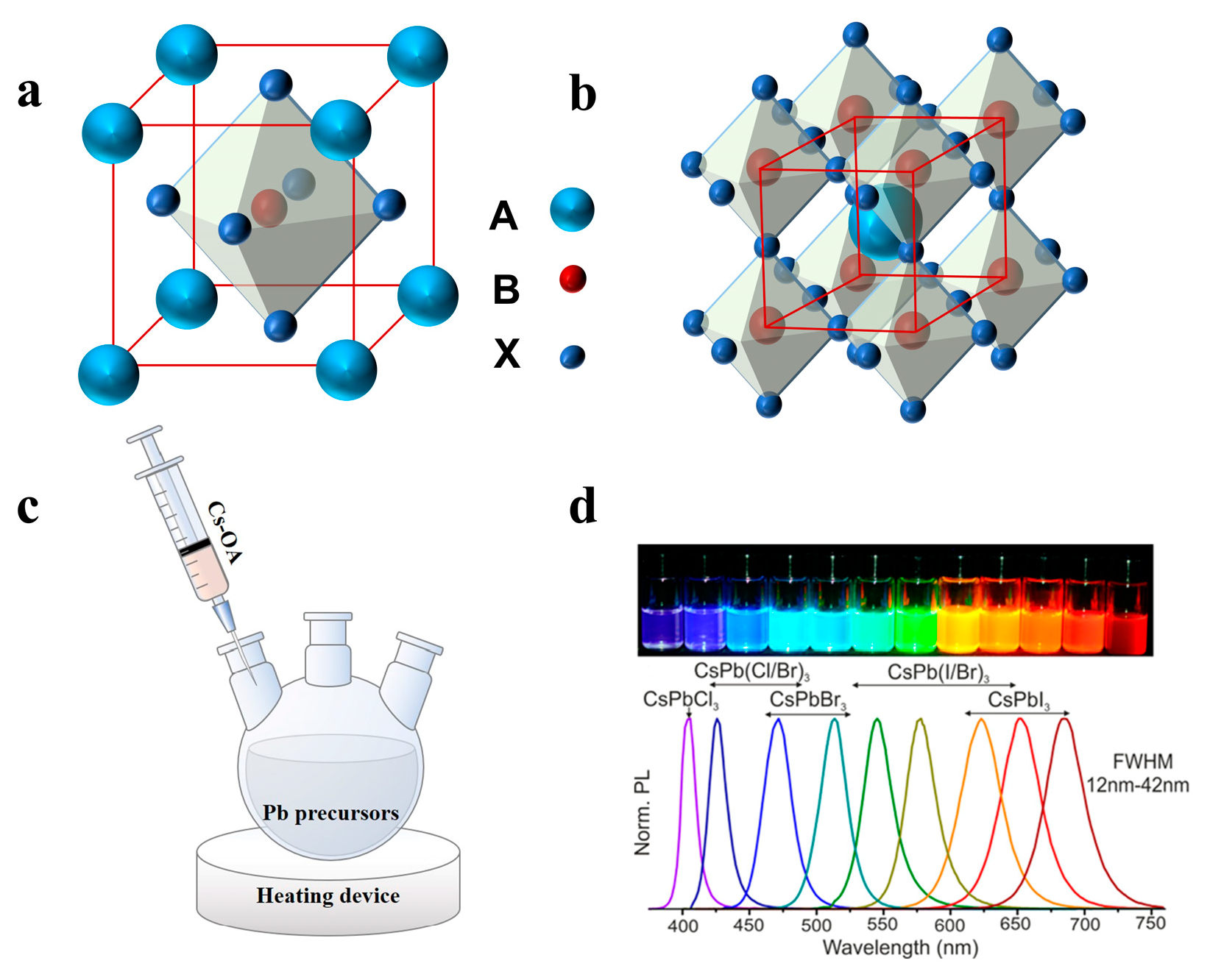


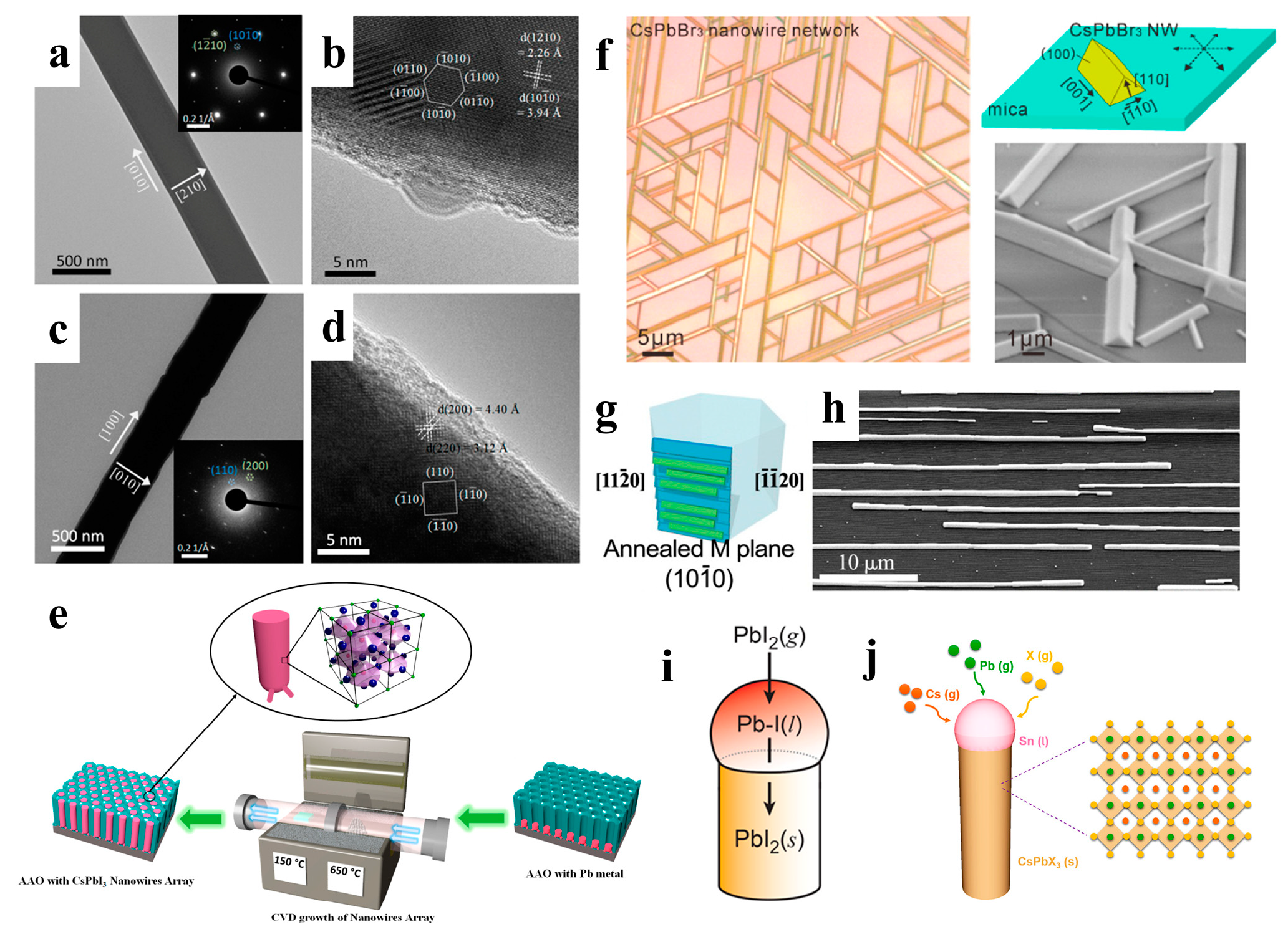
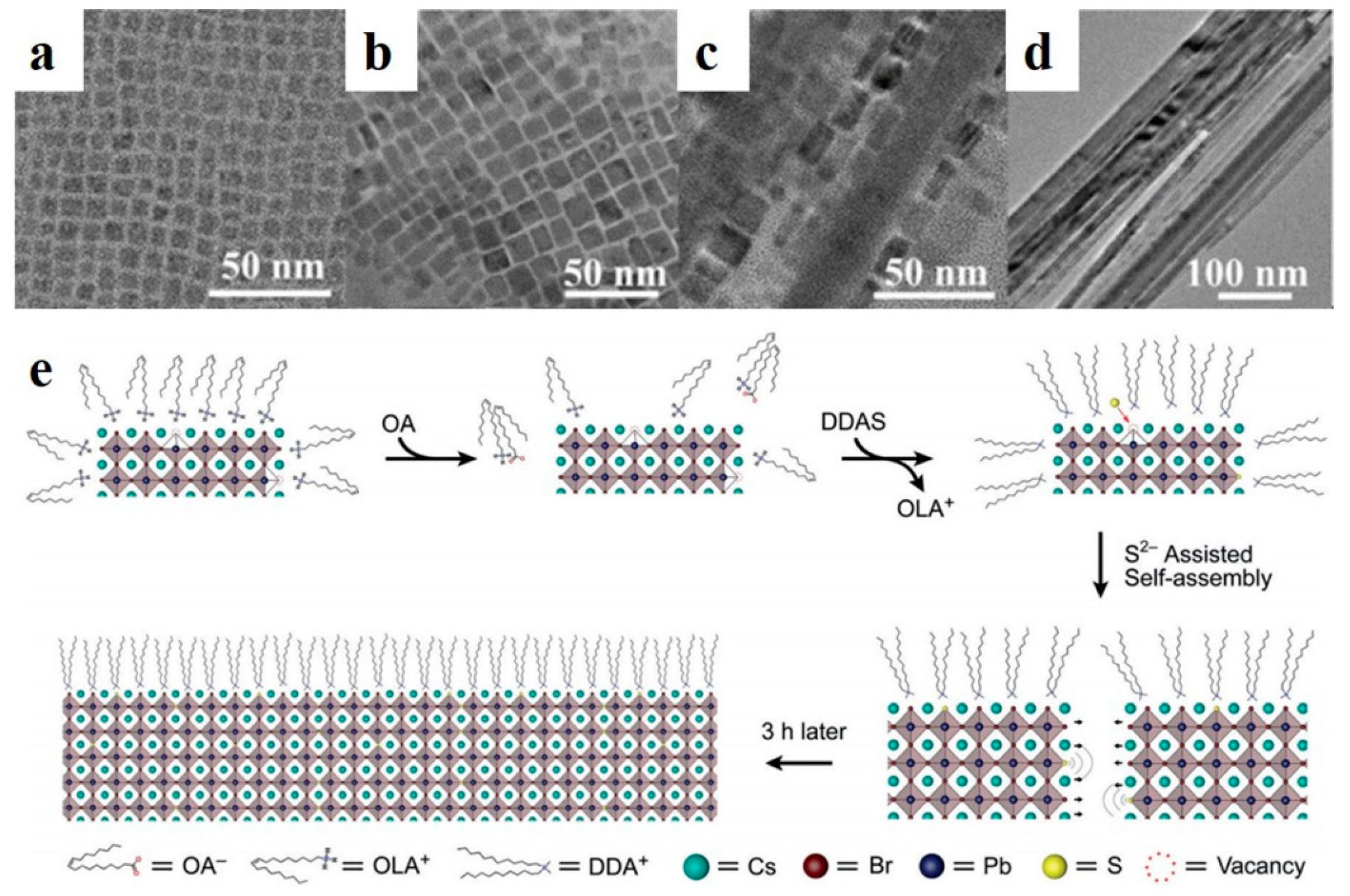
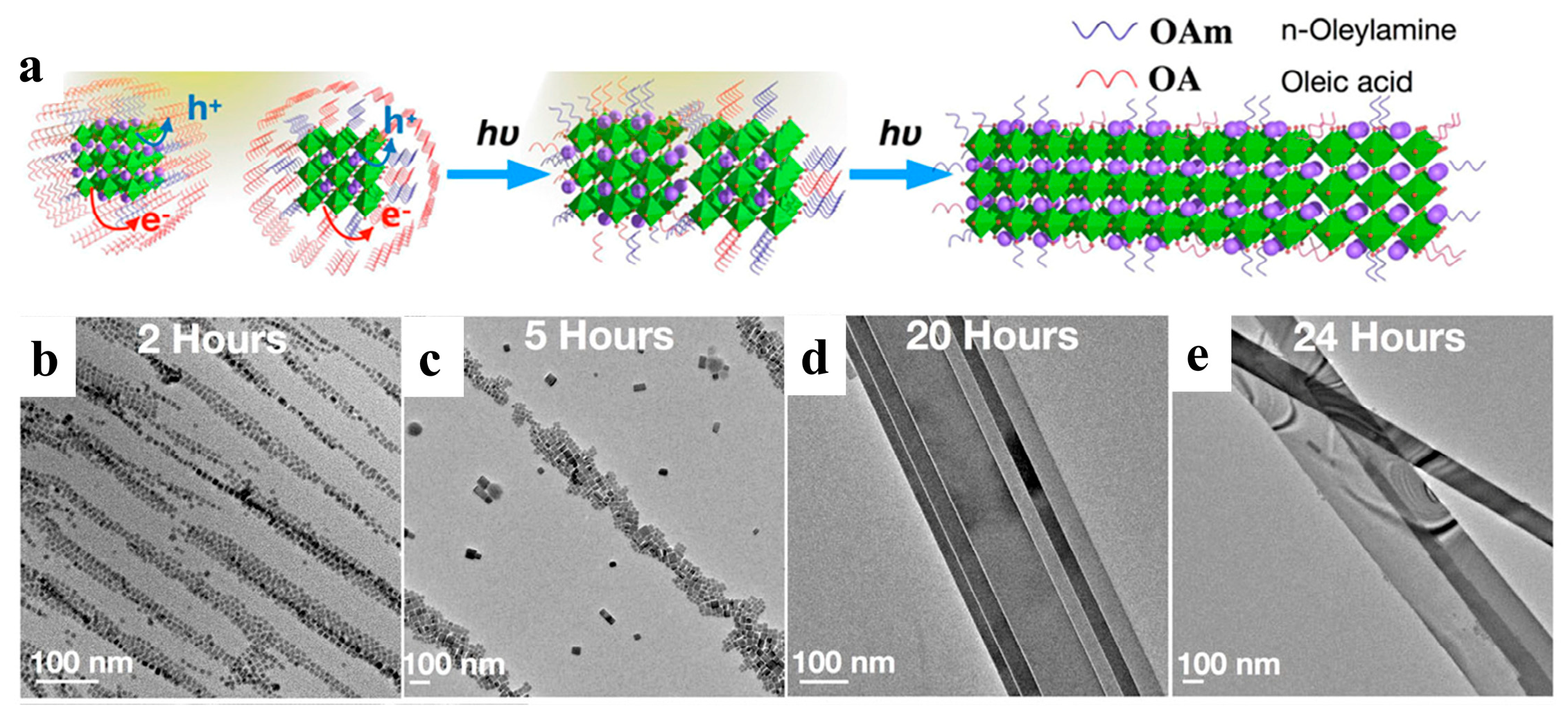

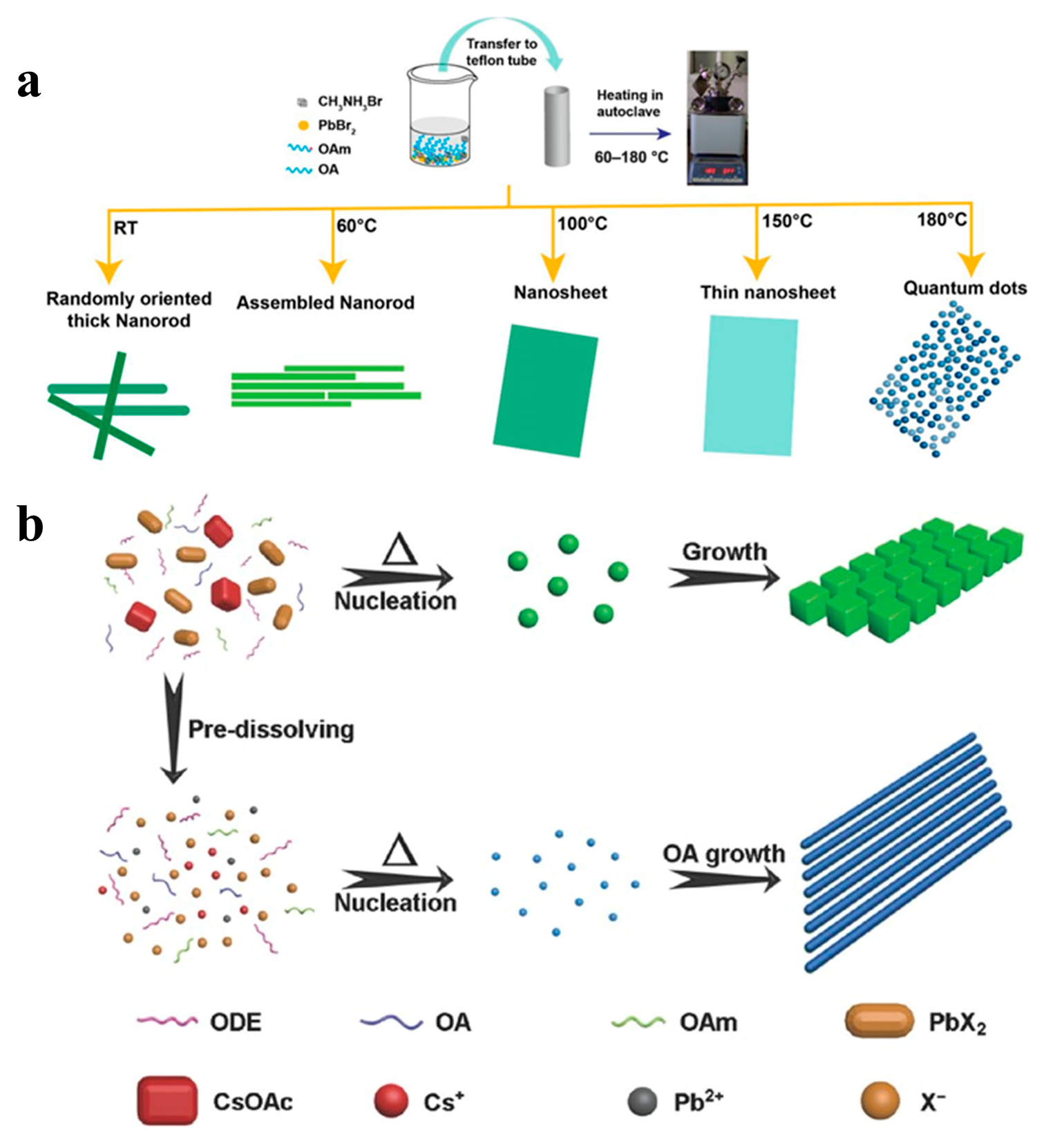
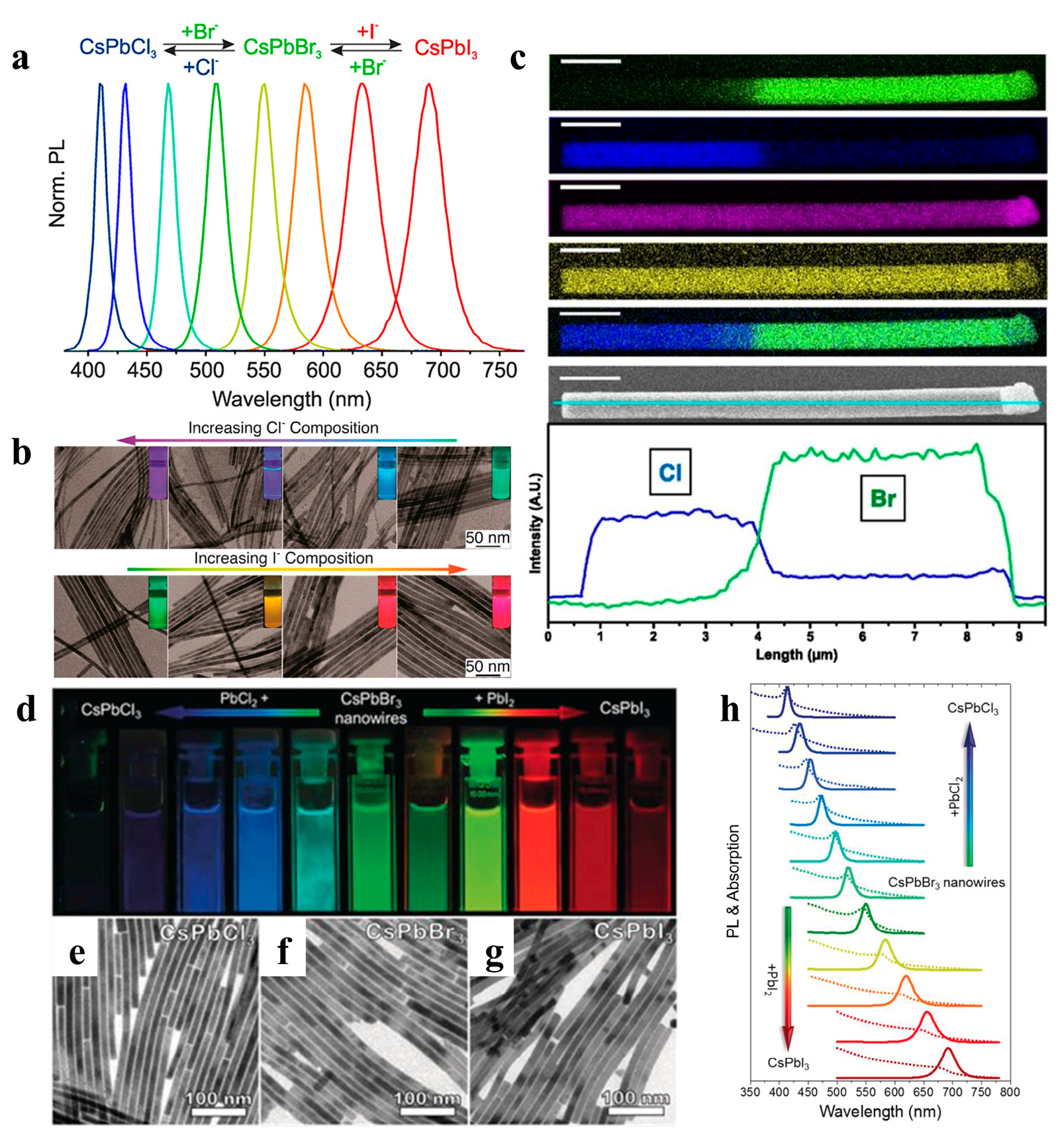
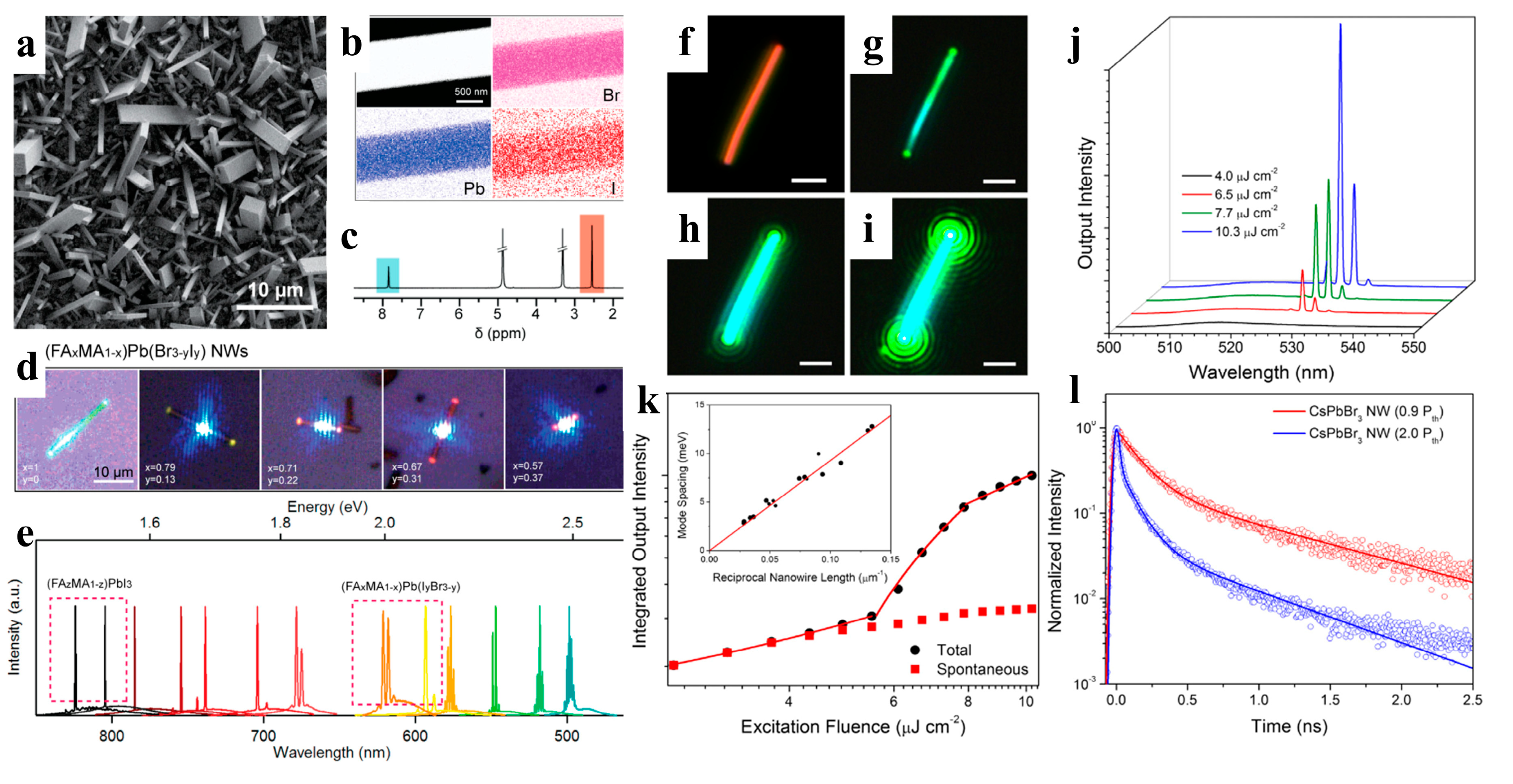




| Perovskite NWs | Synthesis | PL Range (nm) | Diameter (nm) | Length (μm) | Ref. |
|---|---|---|---|---|---|
| CsPbBr3 | HI | - | ~12 | 5 | [16] |
| CsPbI3 | HI | ~685 | 5–80 | 10–20 | [38] |
| CsPbBr3 | HI | 473, 483 | 3.4 ± 0.5 | - | [39] |
| CsPbBr3 | HI | 465 | 2.2 ± 0.2 | Several microns | [40] |
| MAPbI3 | Vapor | - | ~200 | ~10 | [41] |
| CsPbI3 | Vapor | - | 200–250 | ~1 | [42] |
| CsPbBr3 | Vapor | 528 | ~1 μm | Tens of micrometers | [43] |
| CsPbBr3 | Vapor | ~520 | 20–2000 | - | [44] |
| MAPbI3 | VLS | 768 | 100–2000 | Tens of micrometers | [45] |
| MAPbI3 | VLS | - | - | - | [46] |
| CsPbX3 | VLS | 422, 539, 740 | ~150 | - | [47] |
| MAPbBr3 | Ligand | 532 | ~100 | 2–4.5 | [48] |
| CsPbBr3 | Ligand | 525 | 20–60 | Several millimeters | [49] |
| CsPbBr3 | Light | - | Hundreds of nanometers | 10–20 | [50] |
| CsPbI3 | Polar solvent | 690 | Up to submicron | Several micrometers | [51] |
| CsPbBr3 | Polar solvent | - | - | - | [52] |
| CsPbX3 | Solvothermal | 410–700 | ~2.6 | - | [53] |
| CsPbX3 | Anion Exchange | 409–680 | 10 ± 2 | - | [28] |
| CsPbX3 | Anion Exchange | 400–700 | ~12 | - | [54] |
| Material | Devices | Synthesis Method | Wavelength [nm] | Threshold [μJ cm−2] | Quality Factor | Ref. | |
|---|---|---|---|---|---|---|---|
| MAPbX3 NWs | Lasers | surface-initiated solution growth | ~490–~770 | 0.22 | 3600 | [91] | |
| MAPbX3 NWs | Lasers | one-step in situ solution | 548 | 375 | 589 | [92] | |
| FAPbX3 NWs | Lasers | low-temperature solution growth | 490–824 | ~Several | ~2000 | [93] | |
| CsPbX3 NWs | Lasers | low-temperature solution growth | ~430, ~532 | 5 | 1009 ± 5 | [8] | |
| CsPbX3 NWs | Lasers | solution growth | ~425–~722 | 4 | 2256 | [17] | |
| CsPbCl3−3xBr3x NWs | Lasers | chemical vapor deposition | 480–525 | 11.7–35 | - | [94] | |
| CsPbX3 NWs | Lasers | chemical vapor deposition | 425, 525, 725 | 6 | 1300 | [95] | |
| CsPbBrxI3−x NWs | Lasers | vapor-phase epitaxial growth | 521, 556 | 16, 28 | - | [96] | |
| CsPbBr3 NWs | Lasers | wet chemical approach | ~526 | 13 | 7860 | [97] | |
| Material | Devices | Synthesis Method | Responsivity [A W−1] | Rise Time | Decay Time | Ref. | |
| CsPbBr3 NWs | PDs | solution-phase process and halide exchange | 0.3 | 0.4 ms | 0.43 ms | [98] | |
| CsPbBr3 NWs | PDs | graphoepitaxial growth | 4400 | 252 μs | 300 μs | [99] | |
| CsPbxSn1−x(BryI1−y)3 NWs | PDs | two-step solution method | 8.5 × 10−3 | 4.25 ms | 4.82 ms | [100] | |
| CsSnI3 NWs | PDs | hot-pressure welding | 9.9 × 10−3 | 446 ms | 534 ms | [101] | |
| MAPbX3 NWs | PDs | two-step solution method | 0.23 | 53.2 μs | 50.2 μs | [102] | |
| MAPb(I1–xBrx)3 NWs | PDs | a fluid-guided antisolvent vapor-assisted crystallization | 12,500 | 0.34 μs | 0.42 μs | [103] | |
| MAPbI3 NWs | PDs | saturated vapor-assisted crystallization | 460 | 180 μs | 330 μs | [104] | |
| MAPbI3 NWs | PDs | one step selfassembly | 1.32 | 0.2 μs | 0.3 μs | [105] | |
| (MTEA)2(MA)n−1PbnI3n+1 NWs | PDs | capillary-bridge lithography | 7.3 × 103 | 40 μs | 52.2 μs | [106] | |
| MAPbI3 NWs | PDs | two-step spin-coating | 37.14 | 91 μs | 563 μs | [107] | |
| Material | Devices | Synthesis Method | JSC (mA cm−2) | VOC (V) | FF | PCE (%) | Ref. |
| MAPbI3 NWs | PSCs | two-step spin-coating | 19.12 | 1.052 | 0.712 | 14.71 | [108] |
| MAPbI3 NWs | PSCs | two-step spin-coating | 9.1 | 0.98 | 28.65 | 2.55 | [109] |
| MAPbI3 NWs | PSCs | two-step spin-coating | 22.6 | 1.03 | 71.6 | 16.8 | [110] |
| MAPbI3 NWs | PSCs | two-step sequential deposition | 23.92 | 0.819 | 0.547 | 10.72 | [111] |
| MAPbI3 NWs | PSCs | two-step spin-coating | 21.39 | 1.01 | 0.80 | 18.83 | [112] |
| CsPbI3 NWs | PSCs | solution-dipping process | 0.415 | 0.643 | 0.429 | 0.11 | [113] |
| CsPbBr3 NWs | PSCs | solution-dipping process | 2.96 | 0.851 | 0.445 | 1.21 | [113] |
| CsPbBr3 NWs | PSCs | solution growth | 24.1 | 1.12 | 0.791 | 21.4 | [114] |
Disclaimer/Publisher’s Note: The statements, opinions and data contained in all publications are solely those of the individual author(s) and contributor(s) and not of MDPI and/or the editor(s). MDPI and/or the editor(s) disclaim responsibility for any injury to people or property resulting from any ideas, methods, instructions or products referred to in the content. |
© 2023 by the authors. Licensee MDPI, Basel, Switzerland. This article is an open access article distributed under the terms and conditions of the Creative Commons Attribution (CC BY) license (https://creativecommons.org/licenses/by/4.0/).
Share and Cite
Lu, Y.; Qu, K.; Zhang, T.; He, Q.; Pan, J. Metal Halide Perovskite Nanowires: Controllable Synthesis, Mechanism, and Application in Optoelectronic Devices. Nanomaterials 2023, 13, 419. https://doi.org/10.3390/nano13030419
Lu Y, Qu K, Zhang T, He Q, Pan J. Metal Halide Perovskite Nanowires: Controllable Synthesis, Mechanism, and Application in Optoelectronic Devices. Nanomaterials. 2023; 13(3):419. https://doi.org/10.3390/nano13030419
Chicago/Turabian StyleLu, Yangbin, Kang Qu, Tao Zhang, Qingquan He, and Jun Pan. 2023. "Metal Halide Perovskite Nanowires: Controllable Synthesis, Mechanism, and Application in Optoelectronic Devices" Nanomaterials 13, no. 3: 419. https://doi.org/10.3390/nano13030419
APA StyleLu, Y., Qu, K., Zhang, T., He, Q., & Pan, J. (2023). Metal Halide Perovskite Nanowires: Controllable Synthesis, Mechanism, and Application in Optoelectronic Devices. Nanomaterials, 13(3), 419. https://doi.org/10.3390/nano13030419







